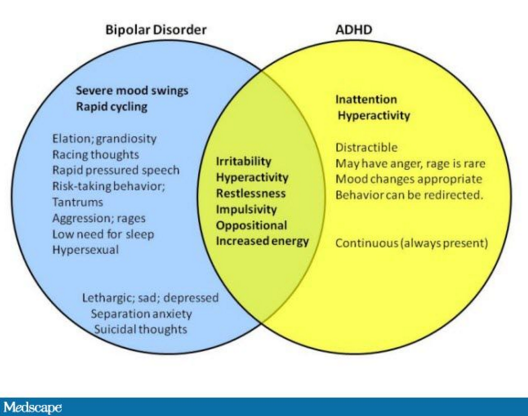ADHD and Bipolar Disorder in Children
ADHD and Bipolar Disorder in Children
 Joseph L. Biederman, MD
Joseph L. Biederman, MD
Over the last twenty years, since the 1990’s, there has been an increasing awareness in pediatric psychiatry that a sizable number of children, probably around one percent, have Bipolar illness. This is also supported by the fact that roughly seventy percent of adults with Bipolar illness start their illness in childhood and adolescence. We face a real problem that somewhere about one percent of children may be affected.
The problem in the field of ADHD and Bipolar illness is that about eighty percent of children with Bipolar illness also have ADHD. It’s not in reverse. The rate of Bipolar illness in children with ADHD is around twenty percent. The overlap is quite substantial, but particularly very, very high in children with Bipolar illness.
The reason this is important is because ADHD and Bipolar in children may share some symptoms, but they require very different treatments. The treatments that we use for ADHD can make worse the symptoms of bipolarity. Particularly if we use medicines like stimulants, or medicines like anti-depressants.

So these things are very consequential to the well-being of the child. Children with Bipolar illness frequently are violent, aggressive, and can be out of control. Very often they are so out of control that they need to be hospitalized. They become dangerous to self or others. So the differential diagnosis of ADHD from Bipolar illness has enormous clinical and therapeutic consequences.
There are shared symptoms in common between ADHD and Bipolar Disorder, but they are different. Hyperactivity and agitation are not exactly the same. Hyperactive children move a lot, but they are not in an agitated state. Children with ADHD tend to talk a lot, but children with Bipolar illness talk so rapidly that sometimes they cannot be understandable.
But the major differentiation is in the abnormal mood. There is nothing in the defining features of ADHD that speak to abnormal mood. Bipolar children have very, very dysregulated mood. They frequently have the combination of aggression, manic symptoms, and depression all at the same time.
It’s a very complicated clinical picture that is usually known as mixed mania. Children with mania, more often than not, tend to be irritable, violent, and aggressive, not euphoric. The children present usually at a very young age, usually with symptoms of dyscontrol, and violence. Very often the symptoms present at home for a long time, before they spread to the school. Because when the symptoms emerge in the school, the child becomes unmanageable and usually is brought to the emergency room.
Despite the fact that some symptoms overlap, there are very, very important differentiating features between ADHD and Bipolarity. Remember I said before that eighty percent of children with Bipolar illness also have ADHD. The ADHD that they have is going to be very severe. But they also have mood dysregulation, irritability, and sometimes violent behaviors.
It is very important for clinicians and parents to learn how to distinguish ADHD from Bipolar Disorder, and treat each appropriately, particularly because of their high comorbidity. ADHD and Bipolar in adults can be similarly challenging, but here we have the maturity of adults who can better describe their symptoms.
